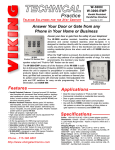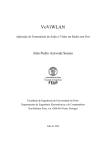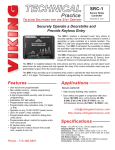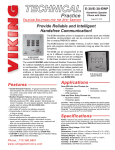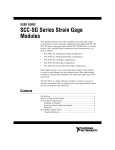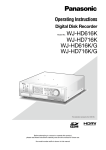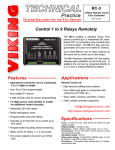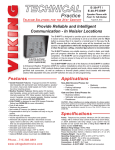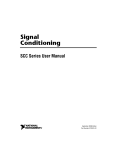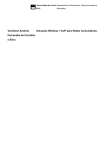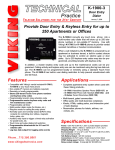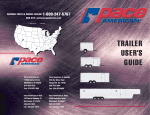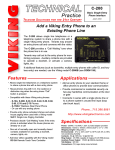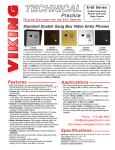Download Viking PB-100 Product manual
Transcript
Designed, Manufactured and Supported in the USA VIKING PRODUCT MANUAL E-10/20/30-IP VoIP Entry Phones C O M M U N I C AT I O N & S E C U R I T Y S O L U T I O N S September 8, 2014 VoIP Entry Phones The E-10/20/30-IP VoIP Entry Phones are designed to provide quick and reliable handsfree communication for SIP VoIP phone systems with PoE. The E-10/20/30-IP entry phones can be programmed from any Touch Tone phone or PC on the same LAN. The Entry phones can dial up to 5 programmable numbers. The E-10/20/30-IP entry phones will flash the “Call” LED during dialing and automatically light the LED when the call is answered. All programming parameters, including phone numbers and location numbers, are stored in non-volatile memory, requiring no batteries. All units are PoE powered. For outdoor installations where the unit is exposed to precipitation or condensation, the E-10/20/30-IP Entry phones are available with Enhanced Weather Protection (EWP). EWP products feature foam rubber gaskets and boots, sealed connections, gel-filled butt connectors, as well as urethane or thermal plastic potted circuit boards. For more information, see DOD# 859. Features • • • • • • • Self diagnostic reports via email (testing com, mic, speaker & switch) Automatic polling and programming software included 2 Amp relay contacts for door/gate or SL-2 strobe light control Blue “Call Connected” LED indicator (E-10/E-30-IP only) SIP compatible (see pg 2 for list of compatible IP-PBX phone systems) PoE powered (class 1, <4 watts) Automatic Noise Canceling (ANC) feature for proper operation in noisy environments • Network downloadable firmware • Handsfree operation • Marine grade 316 stainless steel prevents corrosion on the stainless steel models • Programmable to dial up to 5 numbers on busy or ring no answer • Cycles through backup phone numbers on busy or no-answer • Optional Enhanced Weather Protection (EWP), EWP products are designed to meet IP66 Ingress Protection Rating, see DOD# 859 • Hangs up on busy signal, time-out or touch tone command • Remotely programmable • Extended temperature range (-15°F to 130°F) • 3 different chassis or board only available • Volume adjustments for microphone and speaker • E-10-IP and E-30-IP are flush mountable using the included roughin box or can be surface mounted using an optional VE-5x5 Surface Mount Box (DOD# 424) • Optional PB-100 Polling System available (DOD# 232) • Optional SL-2 or BLK-4-EWP strobe light kit available (DOD# 242/653) E-10-IP/E-10-IP-EWP Flush Mount Black Powder Painted Aluminum E-20-IP/E-20-IP-EWP Surface Mount Light Grey UV Stable Plastic Chassis E-30-IP/E-30-IP-EWP Flush Mount Brushed 316 Stainless Steel E-30-IP/E-30-IP-EWP Shown in Optional VE-5x5 Surface Mount Box Applications • • • • • Gate Entrance Parking ramps/lots ATM machines Medical centers Lobbies • • • • Entryways Stadiums Convention centers Public access areas www.vikingelectronics.com Information: (715) 386-8861 Specifications Power: PoE class 1 (<4 watts) Dimensions: See Installation and Specifications Operating Temperature: -26° C to 54° C (-15°F to 130°F) Humidity - Standard Products: 5% to 95% non-condensing Humidity - EWP Products: Up to 100% Audio Codecs: G711u, G711a, G722 Connections: (1) RJ45 10/100 Base-T, (3) gel-filled butt connectors Beta Units Available 3rd Quarter 2014 Viking VoIP SIP System Compatibility List NOTE: Exclusion from this list means only that compatability has not been verified, it does not mean incompatability. Infrastructure Class Vendor SBC Softswitch 3COM VCX PBX (session border controller) X X X Aastra X Asterisk X Atcom X BlueBox X Brekeke X X Freeswitch X X iptel.org X Kamailio MetaSwitch X OfficeSIP X OpenSIPS X Samsung Communications Manager (SCM) Siemens Communications Server (SCS) X X X X sip.antisip.com X X Sonus Switchvox Teksip X X SIP Express Router (SER) Snom PBX Service Provider X 3CX Cisco Unified Communications Manager (CUCM) Proxy X X X X VoIP.ms X Vonage X 2 Definitions Client: A computer or device that makes use of a server. As an example, the client might request a particular file from the server. DHCP: Dynamic Host Configuration Protocol. In this procedure the network server or router takes note of a client’s MAC address and assigns an IP address to allow the client to communicate with other devices on the network. DNS Server: A DNS (Domain Name System) server translates domain names (ie: www.vikingelectronics.com) into an IP address. Ethernet: Ethernet is the most commonly used LAN technology. An ethernet Local Area Network typically uses twisted pair wires to achieve transmission speeds up to 1Gbps. Host: A computer or device connected to a network. Host Name: A host name is a label assigned to a device connected to a computer network that is used to identify the device in various forms of network communication. Hosts File: A file stored in a computer that lists host names and their corresponding IP addresses with the purpose of mapping addresses to hosts or vice versa. Internet: A worldwide system of computer networks running on IP protocol which can be accessed by individual computers or networks. IP: Internet Protocol is the set of communications conventions that govern the way computers communicate on networks and on the Internet. IP Address: This is the address that uniquely identifies a host on a network. LAN: Local Area Network. A LAN is a network connecting computers and other devices within an office or building. Lease: The amount of time a DHCP server reserves an address it has assigned. If the address isn’t used by the host for a period of time, the lease can expire and the address can be assigned to another host. MAC Address: MAC stands for Media Access Control. A MAC address, also called a hardware address or physical address, is a unique address assigned to a device at the factory. It resides in the device’s memory and is used by routers to send network traffic to the correct IP address. You can find the MAC address of your E-10/20/30-IP phone printed on a white label on the top surface of the PoE LAN port. Router: A device that forwards data from one network to another. In order to send information to the right location, routers look at IP Address, MAC Address and Subnet Mask. Server: A computer or device that fulfills requests from a client. This could involve the server sending a particular file requested by the client. Session Initiation Protocol (SIP): Is a signaling communications protocol, widely used for controlling multimedia communication sessions such as voice and video calls over Internet Protocol (IP) networks. The protocol defines the messages that are sent between endpoints, which govern establishment, termination and other essential elements of a call. Static IP Address: A static IP Address has been assigned manually and is permanent until it is manually removed. It is not subject to the Lease limitations of a Dynamic IP Address assigned by the DHCP Server. WAN: Wide Area Network. A WAN is a network comprising a large geographical area like a state or country. The largest WAN is the Internet. Features Overview IMPORTANT: Electronic devices are susceptible to lightning and power station electrical surges from both the AC outlet and the telephone line. It is recommended that a surge protector be installed to protect against such surges. Rear (PCB) View of E-10/20/30-IP Entry Phone asdesaxtff MAC: 18E80FXXXXXX Green Unit Status LED PoE LAN Port 10/100, PoE Class 1 (<4 Watts): Connect to your LAN via RJ45 plug and CAT5 or greater twisted pair wire. MAC Address Label: The MAC address is aunique 12 digit number used by routers to send network traffic to the correct IP address. Yellow Network Status LED: Lights steady to indicate power and data link. Blinks to indicate network activity. 2 Amp Relay Output Contacts Future Use - Black + Red Black N.C. (Gray) Black Red COM. (Blue) Red White N.O. (Yellow) 3 Gel-Filled Butt Connectors (included) White - Black + Red LED Help Switch Info Switch (optional) Speaker Microphone 3 Installation IMPORTANT: Electronic devices are susceptible to lightning and power station electrical surges from both the AC outlet and the telephone line. It is recommended that a surge protector be installed to protect against such surges. A. Mounting the E-10-IP, E-10-IP-EWP, E-30-IP and E-30-IP-EWP The E-10-IP and E-30-IP are designed to be flush mounted to the included 4” x 4” x 2” deep plastic rough in box or surface mounted using an optional Viking model VE-5x5. Note: The E-10-IP and E-30-IP will NOT mount to a standard double gang box. The plastic rough in box (part # 259576) may be purchased separately. Go to www.vikingelectronics.com and click on “Spare Parts”. 2.1” Front View of Plastic Rough-In Box (included) * 1/8" thick foam 4.0" gasket (included) Wall Stud * Note: Peel off paper liner and adhere gasket to the back of the faceplate, centering it over the four corner mounting holes. 5.0” Typical l Cal Wire knock out (2) Standard flat head dry wall (sheet rock) screws (not included) Push to Call Button (4) 6-32 X 3/4” stainless steel, flat head, hexdrive, screws (included) Condensation Drain Hole 3.25” 5.22” Caution: For rough surfaces (ie: brick, stucco, etc.) additional caulking may be required. (4) 0.38” diameter (for gooseneck mounting) (4) 0.2 x 0.43 slots for double gang box (2) 0.2 x 0.43 slots for single gang box 5.14” (1) .74" dia 3.0” 3.3” The optional VE-5x5 Surface Mount Box is designed to be surface mounted to a single gang box, double gang box or VE-GNP gooseneck pedestal (shown right). For more information on the VE-5x5 and VE-GNP, see DOD# 424. Condensation Drain Hole Front View of Optional VE-5x5 (not included) 2.25” 3.0” Rear View of VE-5x5 (not included) B. Mounting the E-20-IP and E-20-IP-EWP The E-20-IP and E-20-IP-EWP are designed to be surface mounted to a single gang box (not included), a standard 4” x 4” electrical junction box (not included), or directly to a wall or flat sided post. Caution: For rough surfaces (ie: brick, stucco, etc.) additional caulking may be required. Front view of the E-20-IP/E-20-IP-EWP 3.40" Back Panel of the E-20-IP/E-20-IP-EWP Side view of the E-20-IP/E-20-IP-EWP 1.55" UP 3.40" 2.35" 3.30" Call VIKING© To open the speaker box, remove the two separate screws from the cover. Mount back panel to a wall, a single gang box or a 4”x4” junction box with the arrow pointing up. Note: For outdoor applications apply a bead of caulk between back panel and wall. Attach the cover to the base with the two included screws as shown. * Note: The gel-filled (water-tight) butt connectors are designed for insulation displacement on 19-26 gauge wire with a maximum insulation of 0.082 inches. Cut off stripped wire ends before terminating. 4 E-1600-53A-IP Optional Enhanced Weather Protection (EWP) Available* *Optional Enhanced Weather Protection (EWP): The optional EWP products feature foam rubber gaskets and boots, sealed connections, gel-filled butt connectors, as well as urethane or thermal plastic potted circuit boards. See DOD# 859. Note: This is a E-1600A-IP board (PCB) only kit. This kit can be used to convert any Viking E-10A or E-30 analog phone to a VoIP version. The kit can also be used to replace a damaged board in the field. Shipping Weight: .45 kg (1 lb) Connections: (1) RJ45 10/100 Base-T, (3) optional gel-filled butt connectors, (10) additional gel-filled butt connectors included with EWP version only. 3.50 (3.58 EWP) 3.20 0.15 (0.19 EWP) asdesaxtff MAC: 18E80FXXXXXX 2.0 (2.04 EWP) 1.5 (2) 0.156 diameter type 2 mounting holes 8 Optional 2 Amp Relay Output Contacts Connector Connect to doorstrike, mag lock, gate controller, etc. Gray (N.C.) Blue (COM) Yellow (N.O.) ** Note: These two red wires are only used on units with an Info button. When installing on a single button unit, cut off these two red wires and discard. Replacing Analog E-10A, E-10A-EWP or E-30-EWP Circuit Boards: 1 10 1 Cut wires from J1 (10 pin connector) and J2 (2 pin connector). Step 2. Remove the two #6 phillips screws fastening the circuit board. Step 3. Cut off any stripped wire ends from the replacement cable. Using the supplied gel-filled butt connectors, connect corresponding wires from replacement cable Step 4. to the previously cut wires from the LED, Call switch, Speaker and Microphone. See FIGURE 1 for wire color and polarity. 2.63 (2.71 EWP) 0.63 (0.67 EWP FIGURE 1 Replacement Cable Assembly (included ) Connector and Wires from Existing Standard E-30 Analog Entry Phone Black Red Black Black Red** Red** White White Black Red Step 1. Replacement connectors, wires and butt connectors for use when replacing E-10A or E-30-EWP circuit boards. - Black + Red Black Black Red** Red** White White - Black + Red - OR - LED Call Switch Info Switch (not used) Speaker Mic PC Requirements • IBM compatible personal computer with: Windows 2000 (service pack 4 or higher) Windows XP (service pack 2 or higher) Windows Vista (SP2 or newer), 32 or 64 bit versions Windows 7 Windows 8 • • • • • • Adobe Acrobat Reader 8 or higher E-10/20/30-IP hardware Available LAN with PoE (class 1, <4 watts) Ethernet cable ( CAT5 min.) 1 MB minimum free hard drive space for installation 16MB of free physical RAM PC Programming A CD is included with each E-10/20/30-IP VoIP Entry phone. The CD contains the application “Viking VoIP Phone Programming” used to program the unit using a PC running Windows 2000, XP, Vista, Windows 7, or Windows 8 (see System Requirements above). The PC must be connected to the same LAN as the E-10/20/30-IP VoIP phone. Install the application on your PC by placing the CD into your PC’s drive. Click “I Accept” on the bottom of the first screen, then select “Viking VoIP Phone Programming” and click the “Install” button. Follow the directions on the screen. If you are reinstalling the Viking VoIP Phone Programming software you must uninstall the original version first via “Add and Remove Programs”. To start the Viking VoIP Phone Programming application, click on the Viking VoIP Phone Programming icon on your desk top. The Main screen will appear, allowing the user to program any E-10/20/30-IP phone connected to that LAN. A. Configuring the E-10/20/30-IP Network Settings Step 1. Open the “Viking VoIP Phone Programming” software on a windows PC that is connected to the same LAN as the E-10/20/30-IP phone to be programmed. The window in the upper left corner of the menu will show you each E-10/20/30-IP phone that is conStep 2. nected to that LAN. Select the unit with the same MAC address shown on the label located on the top of the Ethernet connector on the E-10/20/30-IP phone. Step 3. Click the “Connect” button. If a pop up window appears, enter the unit’s security code (factory set to 845464) then click the “OK” button. Step 4. The program will then read and display the E-10/20/30-IP phone’s IP and programming settings. Step 5. After adjusting the IP and phones settings, click the “Write” button under each column of settings to send the programming commands to the connected unit. 5 B. Manually Resetting All Network Parameters to Factory Default Step 1. Power down the E-10/20/30-IP phone by disconnecting the RJ45 plug. Step 2. Press and hold the HELP/CALL button, then reconnect the RJ45. Step 3. Continue to hold the button until you hear 2 beeps, (approximately 6 seconds). Continue to hold the button until you hear 4 more beeps, approximately 6 seconds later, then release the button. The “Call Connected” LED will remain off for the first 3 seconds, flash slowly for 3 seconds (2 beeps), fast flash for 6 seconds (4 beeps), then light steady indicating when to release button. Step 4. The unit should continue to output double beeps and slowly flash the LED indicating all Network Parameters are now reset to factory default. Step 5. You must now power cycle the unit by momentarily disconnecting the RJ45. Step 6. You will be required to re-enter your initial network settings prior to any touch tone programming, see section A on page 9. Touch Tone Programming A. Accessing the Touch Tone Programming Mode The E-10/20/30-IP Entry phones can be programmed by calling the unit from any touch tone phone. 1. Using the Security Code to Enter Programming Step 1. From a touch tone phone call the E-10/20/30-IP phone you would like to program. When the E-10/20/30-IP phone answers, enter the 6-digit security code (factory set to 845464, Step 2. see section B). A double beep should then be heard indicating you have entered the programming mode. Step 3. You can now touch tone program the Quick Programming Features listed on page 10. 2. Manually Resetting the Security Code to Enter Programming Step 1. Power down the E-10/20/30-IP phone by disconnecting the RJ45 plug. Step 2. Press and hold the CALL button, then reconnect the RJ45. Continue to hold the button until you hear 2 beeps, (approximately 6 seconds). Then release the Step 3. button. The “Call” LED will remain off for the first 3 seconds, flash slowly for 3 seconds then fast flash (after 2 beeps) indicating when to release button. Step 4. The security code is now reset to 845464 (factory default). Step 5. You can now enter touch tone programming by following the steps in section 1. Using the Security Code, above. B. Security Code (#19) 6 The security code allows the user/installer to program the E10/20/30-IP phone. The factory set security code is 845464 (V-I-K-I-N-G). It is recommended that the factory set security code be changed. Note: The security code must be 6 digits and cannot include a Q or a #. Example: To store 123456 as the security code (shown right). Step 1 Access programming as shown in Programming section A. Step 2 Enter 123456 #19. Step 3 Hang-up. Quick Programming Features (after accessing the Programming Mode) DESCRIPTION ENTER DIGITS + MEMORY LOCATION First speed dial number 0-20 digits + #00 Second speed dial number 0-20 digits + #01 Third speed dial number 0-20 digits + #02 Fourth speed dial number 0-20 digits + #03 Fifth speed dial number 0-20 digits + #04 To clear any speed dial number (no digits) + #00 - #09 Talk/Listen Delay (.1 to .9 sec, factory set to .2 sec) 1 digit (1-9) + #11 Call Length Time Out (0 to 9 min, 0 = disabled, factory set to 3 min) 1 digit (0-9) + #12 Lap Counter (0 to 9, 0 = disabled, factory set to 0) 1 digit (0-9) + #16 Dial Next Number on Ring No Answer (0 or 1 = disabled, 2 - 9 = number of rings, factory set to 7) 1 digit (0-9) + #17 Dial Next Number on Busy (1 or 2, 1 = disabled, factory set to 2/enabled) 1 digit (1 or 2) + #18 Security code (factory set to 845464) 6 digits (0-9) + #19 Identification number (factory set to 987654) 6 digits (0-9) + #20 Access Code (six digits, factory set to 123456) 6 digits (0-9) + #21 Mic volume (0-9, 0 = ANC, factory set to 5) 1 digit (0-9) + #22 Speaker Volume (0-9, factory set to 5) 1 digit (0-9) + #23 Relay Activation Command ( 1 or 2 digits, QQ = Q, QQQQ = QQ, 0-9 or 00-99, factory set to QQ) (Relay Mode must be set to 0 = Door Strike) 1 or 2 digits + #24 Relay Activation Time (2 digits, 00-99 sec, 00= 0.5 sec, factory set to 05) 2 digits (00-99) + #25 Relay Mode (0 = Door Strike, 1 = Phone Active, 2 = Door Bell, 3 = LV-1K Control, factory set to 0) 1 digit (0-3) + #26 Relay Activation Tone (Buzz) Volume (1 digit 0-3, 0 = off, factory set to 3) 1 digit (0-3) + #27 DESCRIPTION ENTER DIGITS Diagnostic tones (used to check mic and speaker operation) Q0 Enable Alternate Switch Action (factory setting) Q1 Disable Alternate switch Action Q2 Enable Latching Commands (factory setting) Q6 Disable Latching Commands Q7 Enable Auto Answer (Factory Setting) Q8 Disable Auto Answer Q9 To add a Q at any point in the dialing string QQ To add a # at any point in the dialing string Q# Reset all Quick Programming Features to factory default settings ### Exit programming and disconnect ##7 7 Programming Features Note: Up to 32 digits can be stored in each dial position via touch tone programming, up to 255 characters via PC programming. Touch tone Q and # count as single digits. A. Speed Dial Numbers (#00 - #09) 1. Speed Dial Numbers (memory locations #00 - #04) The emergency speed dial number programmed in location #00 is the number that is dialed when the ”CALL” button is first pressed. Additional speed dial numbers will be dialed when there is no answer or a busy signal is detected and the next number redial features are activated. To program, enter the desired speed dial number followed by the location number (#00 - #04). To clear a speed dial location, simply enter the memory location (#00 - #04) alone. The E-10/20/30-IP phone is factory set with no speed dial number programmed. To Program: Enter: Q QQ # Q# 0, 1, 2 .... 9 0, 1, 2 .... 9 2. Speed Dial Programming Examples To Program the E-10/20/30-IP Phone... Step 1 Step 2 ...to store 555-1234 as the first speed dial number Enter Programming Enter digits: 5551234#00 (see A. Accessing the Touch Tone Programming Mode, page 10) Enter Programming ...to clear the first speed dial number (see A. Accessing the Touch Tone Programming Mode, page 10) B. Talk / Listen Delay (#11) This feature selects switching time between talk and listen modes (VOX switching time). Use chart at the right. * Note: The factory default is .5 seconds. C. Call Length Time Out (#12) This feature selects the maximum length of time that calls can be connected. Programmable in increments of 1 minute up to a maximum of 9 minutes (Touch Tones 1 - 9). Program 0 in this location to disable the call length time out. With the call length disabled, the E-10/20/30-IP phone must rely on a CPC signal, busy signal, silence or return to dial tone to hang-up. Use chart at the right. * Note: The factory default is 3 minutes. 8 Enter digits: #00 Touch Tone 1 2 3 4 5 6 7 8 9 Talk/Listen Delay .1 sec .2 sec .3 sec .4 sec .5 sec * .6 sec .7 sec .8 sec .9 sec Touch Tone 0 1 2 3 4 5 6 7 8 9 Call Length Time Out Disabled 1 min 2 min 3 min* 4 min 5 min 6 min 7 min 8 min 9 min E. Lap Counter (#16) With the lap counter disabled (factory setting), if the E-10/20/30-IP phone is programmed to dial the next number on ring-no-answer and/or busy signal (see section F and G below), the E-10/20/30-IP phone will continuously call its programmed phone numbers forever until the call is answered. The lap counter is a programmable counter that determines how many times the E10/20/30-IP phone will cycle through its list of up to 5 emergency numbers (or up to 5 “Info” phone numbers), before it stops the dialing process and hangs up. When all of the programmed phone numbers have been dialed, the lap counter is incremented and the dialing process repeats. When the lap counter has been met, the dialing process stops and the E-10/20/30-IP phone hangs up. * Note: This feature is disabled in the factory default setting. F. Dial Next Number on Ring No Answer (#17) If enabled and a ring-no-answer is detected, the E-10/20/30-IP phone will dial the next programmed speed dial number, and continue to cycle through the emergency numbers until a call is completed. * Note: Factory set to redial if not answered after 7 rings. G. Dial Next Number on Busy (#18) If enabled and a busy is detected, the E-10/20/30-IP phone will dial the next programmed speed dial number, and continue to cycle through the numbers until a call is completed. Touch Tone 1 2 Touch Tone 0 1 2 3 4 5 6 7 8 9 Lap Counter Disabled* 1 time 2 time 3 time 4 time 5 time 6 time 7 time 8 time 9 time Touch Tone Ring No Answer 0 1 2 3 4 5 6 7 8 9 Disabled Disabled 2 rings 3 rings 4 rings 5 rings 6 rings 7 rings* 8 rings 9 rings Dial on Busy Disabled Enabled* * Notes: This feature is enabled in the factory default setting. If the busy signal is interrupted with a promotional message, contact your central office to have it removed. H. Identification Number (#20) The Touch Tone I.D. number (up to 6 digits) is used by emergency personnel to identify the location of the caller and is given out when the receiving party presses a Touch Tone Q. The security office can display the number using a Touch Tone decoder. To program the I.D. number, enter the desired number followed by #20. Example: To store 333 as the I.D. number, enter: 3 3 3 # 2 0 9 Operation A. “CALL” Button When the “CALL” button is pressed, the E-10/20/30-IP phone dials a pre-programmed telephone number. The Call Connected LED momentarily flashes during dialing. In the event the line is busy or there is a ring-no-answer, the unit can be programmed to call additional phone numbers. The phone then cycles through up to 5 pre-programmed numbers until the call is answered. When the call is answered, the phones are factory programmed to automatically light the “Call” LED to show that handsfree communication to personnel is established. Once the “Call” LED is on, the # key can be used to force the phone to hang-up. C. Remote Access Operation Commands Feature Tone Tone Command Activate Relay QQ or ___ ___ Un-Latch Relay Q0 Un-latch* (deactivate) the relay. Latch Relay Q1 Latch* (continuously activate) the relay. Disconnect # Disconnects or forces the emergency phone to hang up. Send ID and Play Message Q Send I.D. number (if programmed) and plays the announcement. Description Momentarily activate relay (1 or 2 digits, factory set to QQ). * Note: Latching commands must be enabled (Q6) in programming. 10 Related Products Surface or Pedestal Mount Viking Products While Maintaining Weather and Vandal Resistance The VE-3x5, VE-5x5, VE-6x7 and VE-5x10 add vandal and weather resistance, as well as versatility to many Viking products. The VE-Series backboxes are available in black fine texture powder painted steel or Marine Grade 316 stainless steel. The weather resistant boxes are designed to be surface mounted to a wall, post, single gang box, or a VE-GNP gooseneck pedestal. Note: The VE-3x5 is not compatible with the VE-GNP pedestals and is not available in stainless steel. The VE-3x5 is designed to be used with the E-40-EWP or E-50-EWP Series entry phones. The VE-5x5 is designed to be used with the E-10-IP-EWP, E30-EWP, E-30-PT-EWP, E-60-EWP, E-65-EWP, E-70-EWP, E-75-EWP entry phones, the E-1600-20A-EWP, E-1600-20A-IP-EWP, E-1600-30A-EWP and E-1600-30A-IP-EWP emergency phones, as well as the W-1000-EWP and W-3000-EWP handsfree doorboxes. The VE-6x7 is designed to be used with the K-1700-3-EWP and K-1705-EWP entry phones and the VE-5x10 is designed to be used with the K-1900-7-EWP and the K-1900-8-EWP vandal resistant phones. VE-5x10 VE-5x10-SS VE-5x5 VE-5x10-PNL VE-GNP VE-GNP-SS VE-GNP-IG VE-GNP-2 VE-3x5 VE-6x7 VE-5x5-SS For more information, see DOD# 424 VE-5x5-PNL The VE-GNP gooseneck pedestals are designed to be used with the VE-5x5, VE-6x7 and VE-5x10 VE-5x5-PNL-SS VE-6x7-PNL-SS VE-5x10-PNL-SS backboxes and are ideal for drive up communications. Note: The VE-3x5 is not compatible with the VE-GNP pedestals. The VE-PNL’s are VE-Series backboxes with a blank aluminum panel. The user can customize the clearcoated aluminum panel to mount an PRX-1 card reader, PRX-2 keypad or switch. The kits come complete with box, gasket, panel and screws. Model numbers that end with “SS” are stainless steel version. Note: The use of magnets to mount the VESeries enclosure to a metal surface can affect the operation of the enclosed product. 11 Warranty IF YOU HAVE A PROBLEM WITH A VIKING PRODUCT, CONTACT: VIKING TECHNICAL SUPPORT AT (715) 386-8666 Our Technical Support Department is available for assistance Monday 8am - 4pm and Tuesday through Friday 8am - 5pm central time. So that we can give you better service, before you call please: 1. Know the model number, the serial number and what software version you have (see serial label). 2. Have your Technical Practice in front of you. 3. It is best if you are on site. RETURNING PRODUCT FOR REPAIR The following procedure is for equipment that needs repair: 1. Customer must contact Viking's Technical Support Department at 715-386-8666 to obtain a Return Authorization (RA) number. The customer MUST have a complete description of the problem, with all pertinent information regarding the defect, such as options set, conditions, symptoms, methods to duplicate problem, frequency of failure, etc. 2. Packing: Return equipment in original box or in proper packing so that damage will not occur while in transit. Static sensitive equipment such as a circuit board should be in an anti-static bag, sandwiched between foam and individually boxed. All equipment should be wrapped to avoid packing material lodging in or sticking to the equipment. Include ALL parts of the equipment. C.O.D. or freight collect shipments cannot be accepted. Ship cartons prepaid to: Viking Electronics, 1531 Industrial Street, Hudson, WI 54016 3. Return shipping address: Be sure to include your return shipping address inside the box. We cannot ship to a PO Box. 4. RA number on carton: In large printing, write the R.A. number on the outside of each carton being returned. RETURNING PRODUCT FOR EXCHANGE The following procedure is for equipment that has failed out-of-box (within 10 days of purchase): 1. Customer must contact Viking’s Technical Support at 715-386-8666 to determine possible causes for the problem. The customer MUST be able to step through recommended tests for diagnosis. 2. If the Technical Support Product Specialist determines that the equipment is defective based on the customer's input and troubleshooting, a Return Authorization (R.A.) number will be issued. This number is valid for fourteen (14) calendar days from the date of issue. 3. After obtaining the R.A. number, return the approved equipment to your distributor, referencing the R.A. number. Your distributor will then replace the Viking product using the same R.A. number. 4. The distributor will NOT exchange this product without first obtaining the R.A. number from you. If you haven't followed the steps listed in 1, 2 and 3, be aware that you will have to pay a restocking charge. TWO YEAR LIMITED WARRANTY Viking warrants its products to be free from defects in the workmanship or materials, under normal use and service, for a period of two years from the date of purchase from any authorized Viking distributor. If at any time during the warranty period, the product is deemed defective or malfunctions, return the product to Viking Electronics, Inc., 1531 Industrial Street, Hudson, WI., 54016. Customer must contact Viking's Technical Support Department at 715-386-8666 to obtain a Return Authorization (R.A.) number. This warranty does not cover any damage to the product due to lightning, over voltage, under voltage, accident, misuse, abuse, negligence or any damage caused by use of the product by the purchaser or others. This warranty does not cover non-EWP products that have been exposed to wet or corrosive environments. This warranty does not cover stainless steel surfaces that have not been properly maintained. NO OTHER WARRANTIES. VIKING MAKES NO WARRANTIES RELATING TO ITS PRODUCTS OTHER THAN AS DESCRIBED ABOVE AND DISCLAIMS ANY EXPRESS OR IMPLIED WARRANTIES OR MERCHANTABILITY OR FITNESS FOR ANY PARTICULAR PURPOSE. EXCLUSION OF CONSEQUENTIAL DAMAGES. VIKING SHALL NOT, UNDER ANY CIRCUMSTANCES, BE LIABLE TO PURCHASER, OR ANY OTHER PARTY, FOR CONSEQUENTIAL, INCIDENTAL, SPECIAL OR EXEMPLARY DAMAGES ARISING OUT OF OR RELATED TO THE SALE OR USE OF THE PRODUCT SOLD HEREUNDER. EXCLUSIVE REMEDY AND LIMITATION OF LIABILITY. WHETHER IN AN ACTION BASED ON CONTRACT, TORT (INCLUDING NEGLIGENCE OR STRICT LIABILITY) OR ANY OTHER LEGAL THEORY, ANY LIABILITY OF VIKING SHALL BE LIMITED TO REPAIR OR REPLACEMENT OF THE PRODUCT, OR AT VIKING'S OPTION, REFUND OF THE PURCHASE PRICE AS THE EXCLUSIVE REMEDY AND ANY LIABILITY OF VIKING SHALL BE SO LIMITED. IT IS EXPRESSLY UNDERSTOOD AND AGREED THAT EACH AND EVERY PROVISION OF THIS AGREEMENT WHICH PROVIDES FOR DISCLAIMER OF WARRANTIES, EXCLUSION OF CONSEQUENTIAL DAMAGES, AND EXCLUSIVE REMEDY AND LIMITATION OF LIABILITY, ARE SEVERABLE FROM ANY OTHER PROVISION AND EACH PROVISION IS A SEPARABLE AND INDEPENDENT ELEMENT OF RISK ALLOCATION AND IS INTENDED TO BE ENFORCED AS SUCH. If trouble is experienced with the E-10/20/30-IP phone, for repair or warranty information, please contact: Viking Electronics, Inc., 1531 Industrial Street, Hudson, WI 54016 (715) 386-8666 WHEN PROGRAMMING EMERGENCY NUMBERS AND (OR) MAKING TEST CALLS TO EMERGENCY NUMBERS: Remain on the line and briefly explain to the dispatcher the reason for the call. Perform such activities in the off-peak hours, such as early morning or late evenings. PART 15 LIMITATIONS This equipment has been tested and found to comply with the limits for a Class A digital device, pursuant to Part 15 of the FCC Rules. These limits are designed to provide reasonable protection against harmful interference when the equipment is operated in a commercial environment. This equipment generates, uses, and can radiate radio frequency energy and, if not installed and used in accordance with the instruction manual, may cause harmful interference to radio communications. Operation of this equipment in a residential area is likely to cause harmful interference in which case the user will be required to correct the interference at his own expense. Product Support: (715) 386-8666 Due to the dynamic nature of the product design, the information contained in this document is subject to change without notice. Viking Electronics, and its affiliates and/or subsidiaries assume no responsibility for errors and omissions contained in this information. Revisions of this document or new editions of it may be issued to incorporate such changes. 12 DOD# XXX Printed in the U.S.A. ZF303590 Rev 2
















